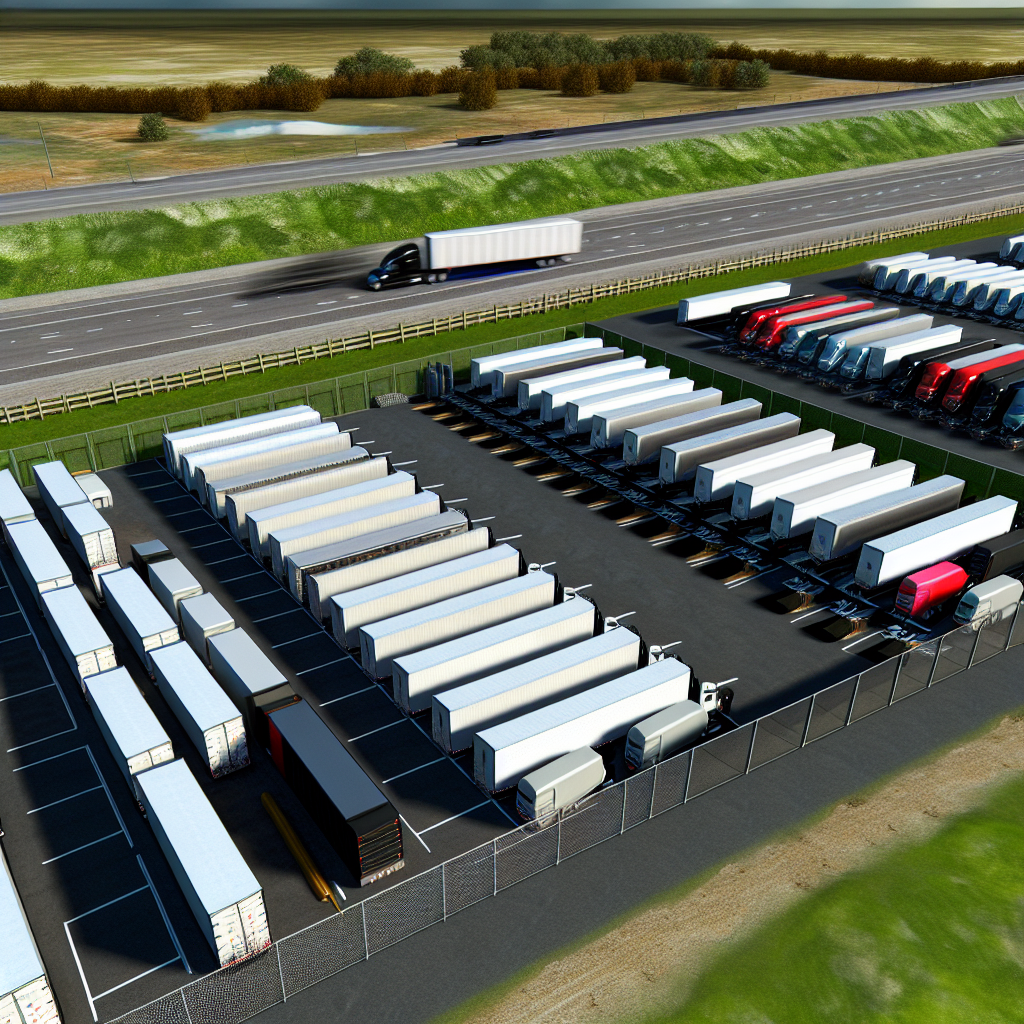In logistics and transportation, understanding economic trends is vital. Currently, trailer orders are low. In August, only 7,261 units were ordered, which is much lower than the 10-year average of 17,568. This drop suggests a slowdown in freight movement and raises questions about the trucking industry’s future.
Adjustments in production and inventory are being made due to ongoing economic challenges. The trucking sector is facing uncertainty that may lead to further instability in the spot market. Since new orders are not matching production, original equipment manufacturers (OEMs) are under pressure to adjust their strategies to fit reduced demand. Stakeholders in the trucking sector must navigate these challenges to remain resilient in a difficult market.

Trailer Order Statistics for August 2025
August 2025 has seen significant developments in trailer orders with the following statistics:
- Total Trailer Orders: 7,261 units were ordered in August, a stark contrast to the historical averages.
- Comparison to 10-Year Average: This figure is approximately 10,000 units below the 10-year August average of 17,568 units.
- Year-Over-Year Changes: There was a 3% increase in orders compared to August 2024.
- Month-Over-Month Changes: Orders decreased by 4% from July 2025, which signifies ongoing volatility in demand.
- Cancellation Rates: Cancellations saw a drop from a high of 39% in May to just 16% in August, indicating some stabilization in the market.
- Year-to-Date Performance: For the year-to-date, the net order total reached 109,800 units, which is about 23% better than the intake for the same period in 2024.
These statistics reflect a challenging yet somewhat improving landscape for trailer manufacturers and suppliers. Stakeholders should remain cautiously optimistic, as underlying economic conditions continue to influence demand patterns.
With builds continuing to outpace new orders, OEMs face mounting pressure to balance production against a thinning pipeline. This emphasizes the urgency for manufacturers to recalibrate their strategies as they navigate current market conditions.
Insights on Market Demand for Trailers and Transport Logistics
The U.S. trailer and trucking industry is currently navigating a complex landscape influenced by economic uncertainties, tariff pressures, and shifting market dynamics.
Decline in Trailer Orders
Recent data indicates a significant downturn in trailer orders. In May 2025, net trailer orders fell by 34% month-over-month to 6,738 units, with order cancellations surging to 37.6% of gross orders—the highest rate in a year. This decline is attributed to economic uncertainty and the impact of increased tariffs on steel, aluminum, and fabricated components. These tariffs have raised production costs for original equipment manufacturers (OEMs) and suppliers. Source
Similarly, in August 2025, trailer orders remained weak, totaling 7,261 units—more than 10,000 units below the 10-year August average. Cancellations, however, decreased to 16% from May’s peak of 39%. Analysts suggest that unless order activity strengthens with the opening of 2026 order boards, the industry may face additional challenges. Source
Economic Challenges and Tariff Impacts
The escalation of tariffs has notably affected the trucking industry. In June 2025, tariffs on steel, aluminum, and fabricated components increased to 50%, significantly raising production costs for OEMs and suppliers. These heightened costs have placed downward pressure on trailer demand, as fleets become more cautious with capital expenditures amid economic uncertainties. Source
Additionally, the ongoing trade tensions have led businesses to stockpile goods to avoid tariffs, temporarily boosting shipment volumes. However, this surge masks underlying weaknesses in key sectors such as domestic manufacturing and ocean imports, suggesting that the current boost is unsustainable and may lead to a slowdown in the near future. Source
Implications for Logistics and Trucking Operations
The combination of declining trailer orders and economic challenges has several implications for logistics and trucking operations:
- Operational Adjustments: Fleets may need to reassess their equipment acquisition strategies, potentially delaying or reducing new trailer purchases to manage costs effectively.
- Capacity Management: With a potential oversupply of trailers due to decreased demand, companies might face challenges in balancing capacity with fluctuating freight volumes.
- Financial Planning: Increased production costs and economic uncertainties necessitate more stringent financial planning and budgeting to maintain profitability.
In summary, the U.S. trailer and trucking industry is contending with a confluence of factors, including declining trailer orders, tariff-induced cost increases, and broader economic uncertainties. These challenges require strategic adjustments in operations and financial planning to navigate the evolving market landscape effectively.
| Year | Total Trailer Orders |
|---|---|
| 2021 | 11,500 |
| 2022 | Not specified |
| 2023 | 11,500 |
| 2024 | 6,661 |
| 2025 | 7,261 |

Current Trends in the Trucking Spot Market Post-Labor Day
In the aftermath of Labor Day 2025, the trucking spot market has faced a mix of challenges and adjustments influenced by broader economic conditions. Spot rates experienced a temporary surge leading up to the holiday, especially for refrigerated loads; however, these rates quickly returned to pre-holiday levels, reflecting the ongoing volatility in the market. Despite this decline, it is noteworthy that spot rates recorded a year-over-year increase of 7.5% in the fourth quarter of 2024. This rise is attributed to various factors, including the stabilization of tender rejections, which have hovered around 10%, and a gradual reduction of capacity from the market as older carriers exit due to competitive pressures.
Adjustment in Trucking Operations
The exit of older carriers has contributed to a significant rebalancing of capacity within the trucking industry. Approximately half of the carrier exits in 2024 involved companies that had been operational for over three years, leading to a more consolidated market. This shift may allow remaining players to optimize their capacity against the current freight demand more effectively. However, the sluggish orders for Class 8 trucks, which saw only a 2% increase in August compared to July but were down 16% year-over-year, suggest that original equipment manufacturers (OEMs) may need to adjust their production strategies to align with the stagnant demand in the freight market.
Broader Economic Implications
The trucking sector’s struggles are compounded by overarching economic issues, primarily driven by tariff-induced disruptions. The significant tariffs imposed on steel and aluminum have escalated production costs, leading to a slowdown in consumer spending, which is critical for freight demand. Data shows that domestic demand for goods and services grew at an annualized rate of only 1.5% in the first quarter of 2025, down from 3% growth in 2024. Furthermore, contraction within the manufacturing sector poses a significant concern, signaling potential challenges ahead for trucking operations.
Recommendations for Stakeholders
Given the current landscape, stakeholders in the trucking industry—be it logistics providers, OEMs, or drivers—must consider proactive strategies to navigate these fluctuations effectively. Companies should focus on capacity management to adapt to supply-demand dynamics, re-evaluating their equipment procurement strategies to avoid overcommitting in challenging economic times. Additionally, logistics providers should enhance their financial planning and budgeting processes, ensuring they are equipped to withstand the impacts of increasing production costs and subdued demand.
The evolving landscape of the trucking industry requires stakeholders to remain agile, adapting to the intricate interdependencies that characterize the current environment. By embracing strategic shifts and staying informed of market indicators, companies can better position themselves to thrive amid adversity in the trucking spot market.

Conclusion and Future Outlook
In summary, the trucking industry is experiencing a complex interplay of factors affecting trailer orders and the spot market. While current trends indicate a significant decline in trailer orders partly due to increased production costs from tariffs, there is cautious optimism that as we move towards 2026, the market may stabilize. Key stakeholders, such as OEMs and logistics providers, will need to navigate these challenges proactively.
As we approach the 2026 order season, understanding the ongoing economic trends, including shifts in demand, inventory levels, and regulatory pressures, will be essential for making informed decisions. Monitoring these dynamics will help stakeholders prepare for potential shifts in the market, ensuring they can adapt their strategies accordingly. By remaining vigilant and responsive, companies can harness opportunities that may arise even in a challenging environment, ultimately positioning themselves for recovery and growth in the years to come.
This proactive approach will be critical in fostering resilience and maintaining competitiveness in an ever-evolving trucking landscape.
The ongoing near-term uncertainty is why ACT’s expectations for subdued build and lackluster order intake levels during 2025 remain intact. This statement from Jennifer McNealy encapsulates the cautious sentiment permeating the industry, emphasizing the need for stakeholders to remain vigilant as the market navigates considerable economic pressures.
To enhance the SEO performance of the article discussing trailer orders and trucking trends, the following relevant keywords and phrases can be strategically integrated into the content:
- Trailer Orders Decline: Represents the significant downturn in trailer orders due to economic uncertainties and tariffs.
- Freight Recession: Indicates a prolonged period of reduced freight demand, with projections extending into 2026.
- Tariff Impact on Equipment Pricing: Highlights how increased tariffs on materials have influenced production costs for trailers and trucks.
- Fleet Renewal Strategies: Describes how fleets are focusing on asset replacement rather than expansion, influenced by economic pressures.
- Regulatory Compliance and Emissions Standards: Pertains to the challenges fleets face in meeting evolving regulations.
- Capacity Rebalancing: Refers to the industry’s efforts to align fleet capacity with fluctuating demand.
- Spot Market Volatility: Describes the fluctuations in spot market rates affecting profitability.
- Driver Shortage and Workforce Dynamics: Addresses the ongoing recruitment challenges within the industry.
- Economic Indicators in Trucking: Includes metrics that signal the health of the trucking sector.
- Technology Integration in Freight Operations: Covers the use of advanced systems to enhance operational efficiency.
- Sustainability Initiatives in Trucking: Encompasses the introduction of electric trucks and other green practices.
- Supply Chain Disruptions: Highlights challenges affecting the transportation sector, such as delays.
Service-Based Keywords:
- “freight transport services [region]”
- “LTL shipping companies near me”
Location-Based Keywords:
- “auto transport [city name]”
Long-Tail Keywords:
- “reliable vehicle shipping services”
Incorporating these keywords strategically throughout your article will help attract more qualified traffic and enhance its visibility on search engines, allowing it to perform better in the competitive trucking information landscape.


